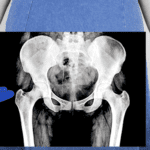Urinary incontinence is a common condition that female and male athletes should feel free and confident to discuss.
Can we PLEASE put an end to the taboo already?
Athletes (male & female) hit the porta-potties just about 7 times to prevent it. Running routes are plotted strategically to relieve it. Dark bottoms are worn to disguise it… so let’s just put it out in the open and deal with it!
With that said, what is urinary incontinence?
Urinary incontinence is defined as “the involuntary leakage of urine” and is a common problem in the female population with prevalence rates varying between 10% and 55% in 15- to 64-year-old women. In men, the prevalence of incontinence is much lower than in women, about 3% to 11% overall.
Urinary incontinence is extremely common but not normal. Most people should be able to last two to three hours between urine breaks….

Why Can’t I Hold My Pee When I Run?
Most of the females we work with really struggle to grasp the concept that having a leaky bladder is NOT normal. It is a dysfunction between your core and your pelvic floor.
Your pelvic floor is supposed to keep your urethra closed. The urethra is a tube that runs from your bladder to the outside and is only supposed to open once your brain tells it to. When the pelvic floor muscles become weak, or there is an imbalance/disconnect between deep core muscles and the pelvic floor, this is when urine will leak when you sneeze, jump or run.
Types Of Incontinence
1. Urge Incontinence
This type of incontinence is when you have the urge/ feeling that you need to urinate, but you have an empty bladder.
Urge incontinence is caused by years of bad habits, such as holding in your urine when you have a full bladder. This allows your neural pathways to get used to that feeling and then later on in life, you still have that urge/feeling.

2. Urinary Stress Incontinence
This is when you have leaking urine, this is caused by stress (any impact or pounding) and how your pelvic floor interacts with your core.
Most people think that when they leak a little bit of urine while doing exercise like running, it’s because of a weak pelvic floor. Very often it can be BUT… it also has a lot to do with how the Pelvic floor interacts with the core and can also be due to a tightness (which is very connected with the weakness) of the pelvic floor.
Pelvic Floor & The Core
It’s been said countless times that normal pelvic function is about strength…
We’re here to tell you that it is about strength but not strength alone.
A normal pelvic function is about being strong and not tight … as opposed to being weak and tight.
The goal of building strength and ensuring that we are not tight is to get our pelvic floor muscles to be working in conjunction with our deeper core, with a focus on our transverse abdominal muscle as well as our diaphragm.
The pelvic floor + diaphragm working together = Intraabdominal pressure
When we run, every step we take affects Intraabdominal pressure. If there is an imbalance or weakness or something not working in the way it should, it affects the pressure and hence leakage.

Why Is Urinary Incontinence More Common In Females Than Males?
Urinary incontinence occurs more often in women than in men. This is because of two reasons:
- Childbirth
- Menopause
Weak bladder muscles, overactive bladder muscles, and nerve damage may also cause urinary incontinence in women.
The good news is that urinary incontinence in women is treatable.
Childbirth
Giving birth is tough on the body and can affect a woman’s urinary control abilities. During pregnancy and while giving birth, the weight of the expanding uterus can weaken the strength of a woman’s pelvic floor muscles.
Natural birth
Compromises the integrity of the pelvic floor and the balance between the deep core and the pelvic floor.
C-sections
They cut through the transverse abdominus (TA), affecting the strength of the TA and therefore the deep core and balance between this and the pelvic floor
For both – scar tissue will also play a role in affecting how the muscles contract and work together.

Menopause
We start the aging process in our third decade of living. When we get to around 50, we lose muscle mass as a natural function of aging. Therefore losing strength.
For menopausal women, it’s not just loss of strength but also changes in ligaments and other connective tissues composition
If you would like to learn more about running during peri and post-menopause then you should definitely read our definitive guide to running to, through, and long after menopause.
Staying fit can help with many symptoms of menopause, what’s even better is that all the positive benefits of running (physical and mental well-being) still apply.

Join us for a free online presentation of the…
The Running Through Menopause Masterclass
…and discover how you can run well (and faster) as you get older, without training more or harder than you currently are, all while avoiding injury.
If it feels like you’re training harder than ever but not running the paces you’d like to be running or if you’re constantly tired, fatigued or running in some sort of pain, then this is specifically for you.
Save Your Seat In This Training Now…
Remember, Urinary Incontinence Is Not Normal
Your pelvic floor is a muscle, there is a loss of integrity in your muscle as well as a change in your ligaments. Your ligaments become laxer, there is a loss of different collagen fibers, and this all results in everything not holding in place as it once did which leads to a leaky bladder.
Now that we have established that this is not just about Kegels and strengthening, this is not something that you can self-diagnose.
If you are leaking urine when you exercise, whether it be while you are gyming or running, even when you jump up and down, or when you do absolutely anything….
Remember it is NOT normal.
That’s why we urge you to seek out a Pelvic Floor Specialist or a physio who specializes in female health. They can help with your diagnosis because as we mentioned earlier it’s not just about a weakness, it can be about tightness.

Seeking out a specialist will go a long way in helping with your diagnosis.
The specialist will be able to define whether it is due to a strong concern or a tightness or an imbalance in the way the muscles contract and therefore be able to treat it accordingly…
If we try self-diagnose and we assume it’s a strength concern (as an example) more strengthening will make that muscle tighter. When in fact perhaps the muscle needs to be released as it’s too tight.
For example, we have chatted to female health experts who mention that just one or two treatments of just trigger pointing could maybe make a huge difference, and then you should only start strengthening thereafter.
As we have established, it’s not just about strength but about how your pelvic floor interacts with your deep core and your diaphragm… So let’s see how we can help with that interaction.
Ways To Help a Weak Bladder
- Breathing
- Slow Progress
Breathing
As we established above, many people wrongly think leaking while running is just caused by a weak pelvic floor and they need to do more Kegels to strengthen it….
The pelvic floor is one part of the muscle system that makes up your deep core, it provides stability and support for your organs as well as for your urinary function. Above your organs is your diaphragm and on the sides are your abdominals.
When you breathe in: Your diaphragm and pelvic floor both relax downward and your ribs and belly expand outward.
When you breathe out: they naturally draw up and in.
The motion of breathing in and out is important as it helps to absorb impact and manage pressure.
If you grip your abs or squeeze your pelvic floor to try to prevent urine leaking, you can actually make it worse.
If you do have weakness in your pelvic floor, doing lots of Kegel exercises alone isn’t the answer.
In this video, I share a breathing technique that you can use at home that can make a huge difference.
Slow Progress
At Coach Parry, we highly recommend taking things super slow. Run your easy runs extra easy and try alternating running and walking. (Walk when you notice you’re not maintaining the right form or breathing). This strategy will help you feel the correct breathing pattern and body alignment.
In this video, you’ll discover how to implement a run/walk strategy in your training.

Remember, there are lots of possible reasons your pelvic floor might not be functioning the right way. Overly tight muscles are more common than weakness, so booking an appointment with a Pelvic Floor Physical Specialist can tailor a program that will help just for you.




Comments are closed.